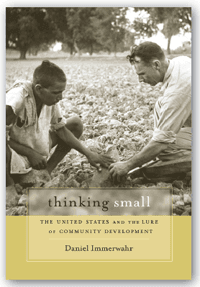
Thinking Small: The United States and the Lure of Community Development
Daniel Immerwahr
253 pages, Harvard University Press, 2015
“This is a book about poverty and the ways in which people have made sense of it,” Daniel Immerwahr writes in the first sentence of the preface to Thinking Small. But in the book, he has almost nothing to say about actual poverty, nor does he analyze the impact of specific poverty-fighting strategies. Instead, he rummages through a mass of scholarly, popular, and political discourse—discourse that spans several continents and several decades—which, he contends, illuminates an epic debate between centralized and decentralized development policies.
If to the proverbial hammer, all objects take on the appearance of a nail, then to Immerwahr, every utterance—every work of fiction, every polemical message, every ideological musing—takes on the appearance of an argument about the proper scale of social and economic development. In one corner are the centralizers. They call for dams, irrigation systems, and other large-scale, top-down forms of modernization. Immerwahr actually doesn’t write much about them; instead, they serve as a backdrop to his argument. In the other corner are the decentralizers. They call for community organizing projects, bottom-up hygiene initiatives, and other efforts to bring “power to the people.” They are the focus of attention here.
Immerwahr takes the reader on a grand tour of (largely unsuccessful) community development experiments in India, the Philippines, and the United States between the 1930s and 1960s. Along the way, he conducts side trips to China, Vietnam, and elsewhere. His accounts of those experiments are often fascinating, either because they cover unfamiliar territory or because they tie familiar details together in a surprising manner. I lapped up every word of these accounts.
Indeed, the most interesting chapters in Thinking Small document examples of community organizing gone haywire. In India, community development, rather than empowering the local poor, resulted in oppressive alliances between government officials and local elites. In the Philippines, community development served the purpose of counterinsurgency, not economic development.
But Immerwahr never makes clear exactly where his grand tour leads. He discusses episodes and ideas without offering any analysis to help us make sense of them. If his purpose is modest—to make readers aware of the mid-20th-century origins of community development theories that are reappearing in current debates—then he succeeds. But if his purpose is to convince readers that today’s policy discourse takes too little account of the failed infatuations of an earlier generation of policy makers, then he only partially succeeds. That’s because he provides no test of the all-important word “too” in “too little account.”
If readers expect to learn something about economic development or poverty alleviation, then this book will disappoint them. Immerwahr does not marshal evidence on behalf of one anti-poverty strategy or another. If cliometric historians err on the side of applying formal theory and quantitative methods, then he errs in the opposite direction—toward a reliance on theory-free anecdotes. He presents his anecdotes skillfully, and they are valuable in their own right. But anecdotes don’t add up to arguments. Immerwahr never clearly states and tests a proposition. Nor does he set forth facts in a way that would allow others to test or refute his take on history.
Immerwahr’s review of mid-century discourse on issues related to community development glides over a broad array of scholars, policy makers, politicians, and other luminaries. Here’s a sampling, listed in no particular order: Mahatma Gandhi. Saul Alinsky (community organizer). Jimmy Carter. Gunnar Myrdal (economist). Mary Parker Follett (social worker and organizational theorist). Frederick Jackson Turner (historian). Max Shachtman (Marxist theorist). Frederick Winslow Taylor (management consultant). Norman Rockwell (painter). Sinclair Lewis (novelist). Edgar Lee Masters (poet). David Riesman (sociologist). Herbert Gans (sociologist). Y.C. James Yen (Chinese educator). Jane Jacobs (urban theorist). Huey P. Newton (cofounder of the Black Panther Party).
The sweep of these references—and there are many more—is truly stunning. But Immerwahr never explains the criteria that he has used to decide which voices to include.
Immerwahr, writing as a historian, warns us against embracing policies that have failed in the past. Fair enough. But do readers today need that reminder? No one comes away from the literature on economic development and thinks that experts in the field fall into neat camps—centralizers versus decentralizers, or dam builders versus community organizers. Readers who sift through the writings of economists such as Abhijit Banerjee, Jagdish Bhagwati, William Easterly, and Joseph Stiglitz will not conclude that any of them claims that there’s a proven way to cure entrenched poverty.
Economists who write on this subject don’t feel compelled to choose between dam building and local organizing. Some dams make sense. Others do unspeakable harm. Some local development works. And some local development doesn’t. Life does not present policy makers with a simple choice between “modernization,” in the form of top-down infrastructure projects, and community development. Instead, they need to ask probing questions: Which dam? What kind of dam? Which community? What kind of development? To brush aside local initiatives comes perilously close to being glib. Consider the Millennium Villages Project, an initiative that the economist Jeffrey Sachs is overseeing in sub-Saharan Africa. Sachs’s work may wind up saving millions of lives. Or his efforts may prove fruitless. Immerwahr’s treatise, operating at 30,000 feet in the air, offers no insight on how to evaluate such projects.
That said, although we don’t need Immerwahr to remind us that polices based on localism will not pave an obvious route to progress, we can nonetheless prize his detail-rich historical overview of this topic. Thinking Small offers no clear argument for readers to digest. But perhaps the bounty of material that Immerwahr has gathered will become grist for someone else’s intellectual mill.

